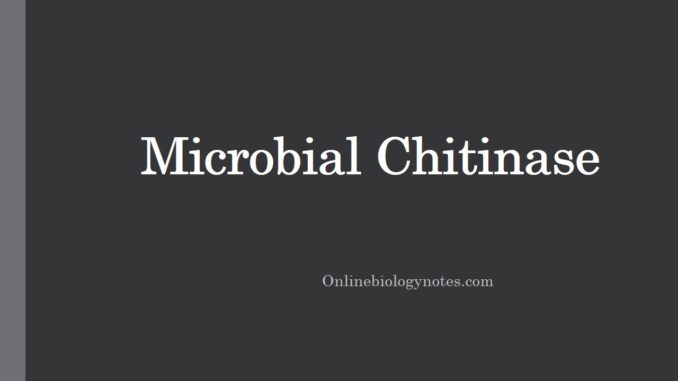
Chitinase:
- Chitinases are hydrolytic enzymes with the size ranging from 20kDa to about 90kDa.
- Chitinase present in wide range of organisms such as bacteria, fungi (molds), actinomycetes, plants, arthropods, and humans.
- Chitinases have the ability to degrade chitin directly to low molecular weight, chitooligomers by acting on glycoside bonds of chitins.
- Chitooligomers have broad applications in industrial, agricultural and medical field and it also acts as anti-tumour agent.
- Chitin is the component of cell walls of fungi and exoskeletal element of some animals including worms and arthropods.
- Chitinases are commonly found in organisms that either need to reshape their own chitin or dissolve and digest the chitin of fungi or animals.
- Types of chitinase:
- Three types depending on pH optima:
- Acidic chitinase
- Neutral chitinase
- Alkaline chitinase
- Three types depending on pH optima:
- On the basis of function, chitinases are of two types:
- Exo-chitinases
- Endo-chitinases
- Exochitinase cut down from non-reducing end of chitin and give rise through dicetylchilobiose.
- Endochitinase randomly cleaves internally forming the dimer dicetylchitobiose and soluble low molecular mass multimass such as chitotriose and chitotetraose.
Chitinase producing Microorganisms:
- Most important: Actinomycetes, Streptomyces spp., Nocardia spp., Streptoverticillium spp., Actinoplane, Trichoderma spp.
- Other: Acromonas spp., Bacillus spp., Pseudomonas spp., Vibrio, Escherichia, Serratia spp.
Production process of chitinase:
- Inoculum:
- Improved strain of Streptomyces viridificans
- Growth of Inoculum:
- Growth in media like starch casein agar, outmeal agar.
- Incubation for 10-12 days at 30oC, growth till spore suspension.
- Inoculum preparation:
- Spore is inoculated in a broth medium containing starch+ glucose +peptone +yeast extract+ ammonium nitrate+ others.
- Incubation: at 30oC for 48hrs.
- Aeration: 0.2vvm
- Agitation: 150rpm
- Fermentation process:
- Top fermentation: Lyophilized culture of S. viridificans is used.
- Batch culture is usually used.
- Fed batch can also be used.
- Stirred tank bioreactor is used.
- Substrates: starch from plant usually from potato or starch corns.
- Nitrogen source: oat milk, soya milk and yeast extract.
- Inducer: 4-5%chitin
- Other: Mg, P etc.
- Inoculum size: 8-10%
- Temperature: 30oC
- pH = 7.2(+ or – 0.2)
- Aeration: 0.2-1 vvm
- Agitation =150rpm
- Duration: 3-4 days
- Product recovery:
- Whole substrate is extracted vacuum filtration and centrifugation and the recovered substance is concentrated by evaporation to yield chitinase and thus obtained crude enzyme is further purified.
Applications of chitinase
- Mostly used in pesticides formulation to control insect pest. E.g. Bacculoviruses is used for biological control of insect pest, also produces chitinases for pathogenesis.
- Pharmaceutically, used as anti-cancer compound.
- Used for degradation of high chitin containing biomass into useful components.
- Chitinase activity in human serum have a role in defense against fungal pathogens.
